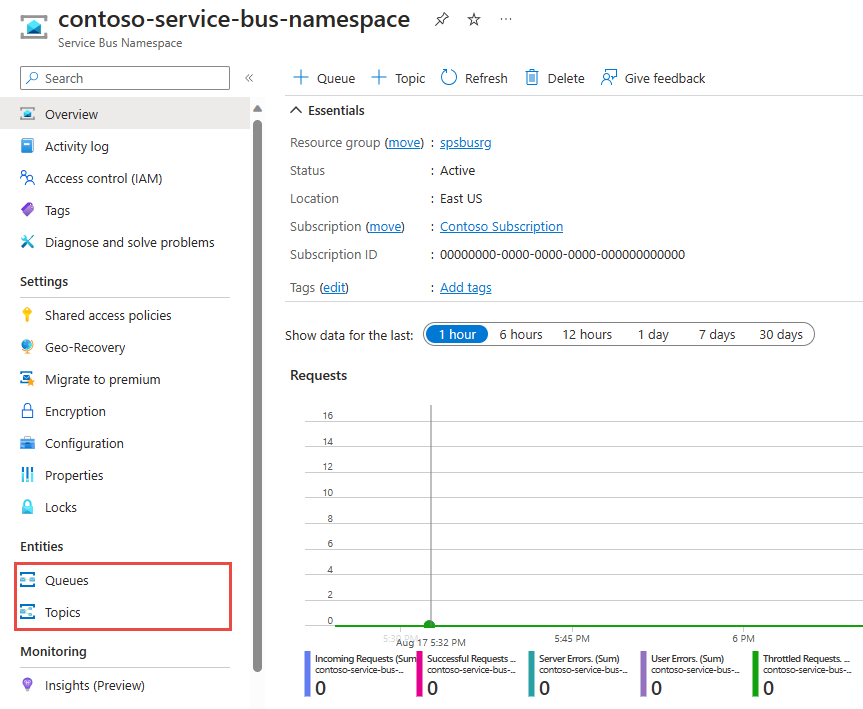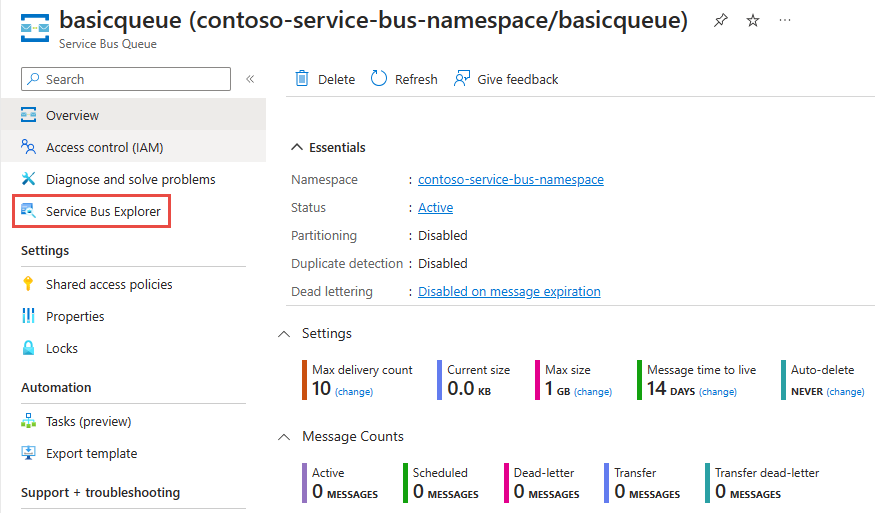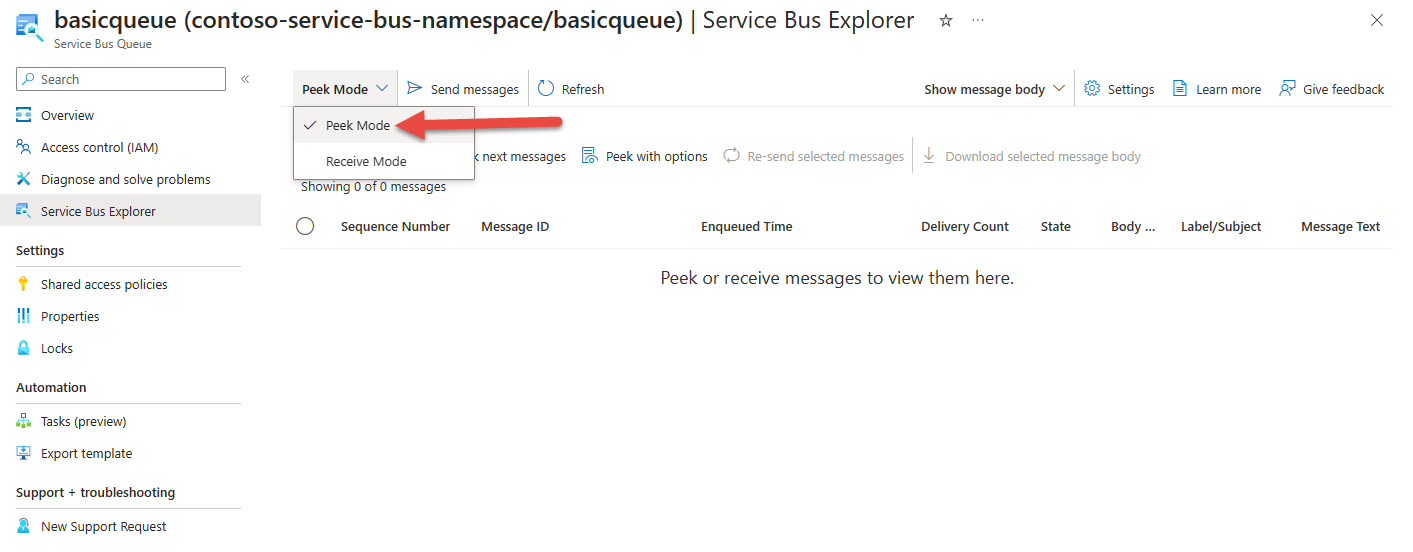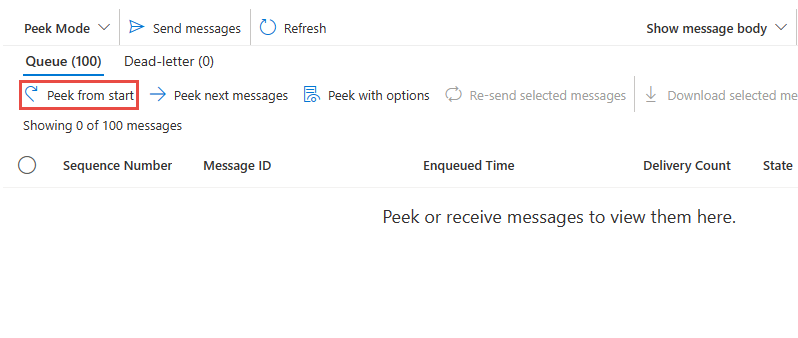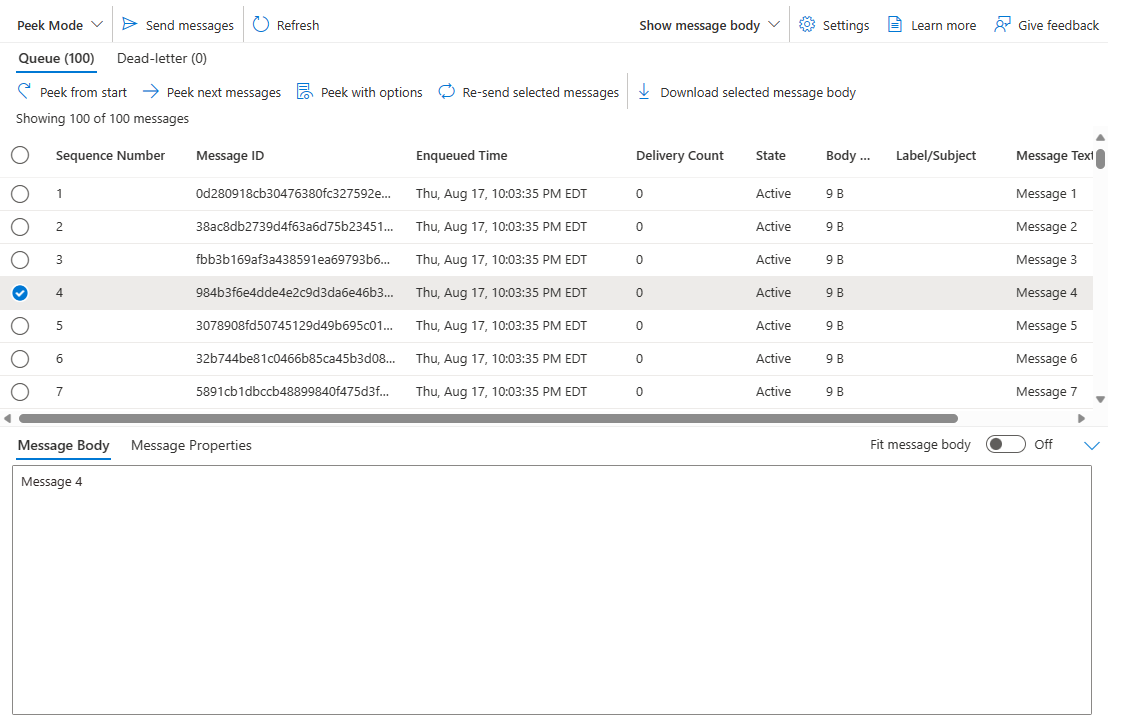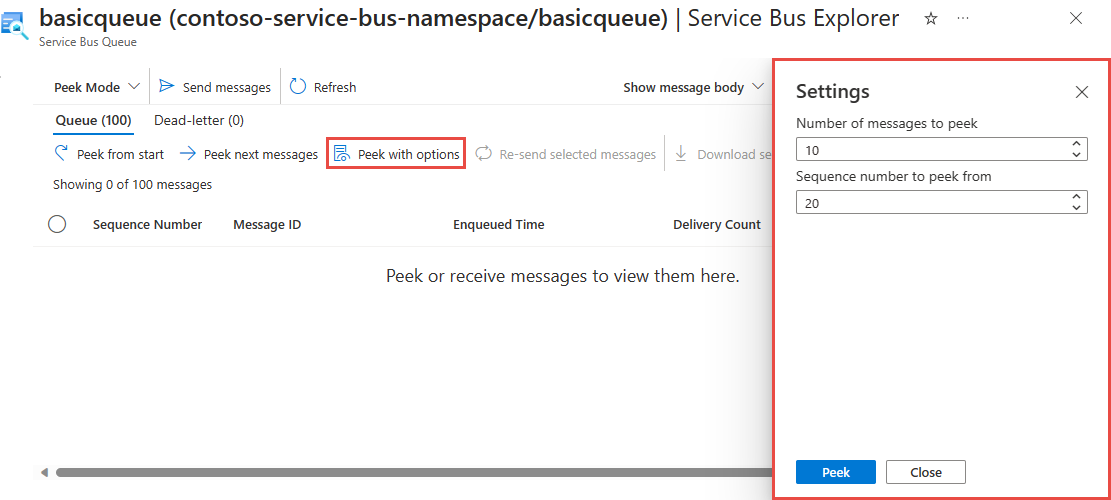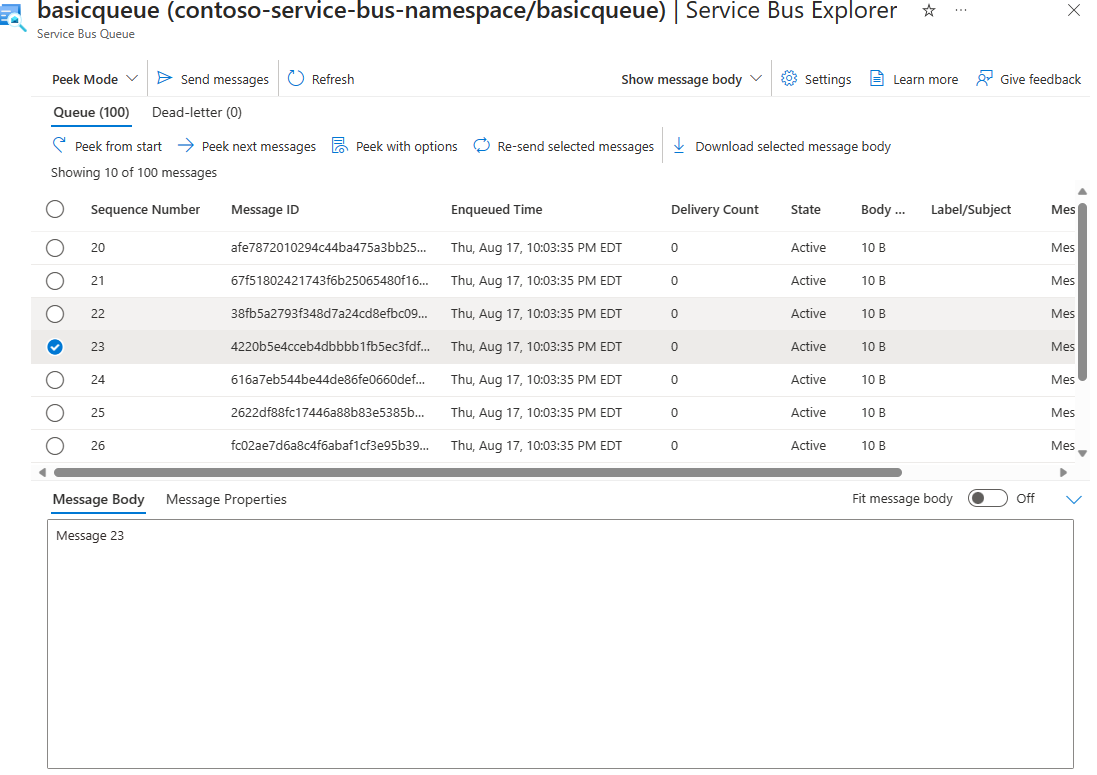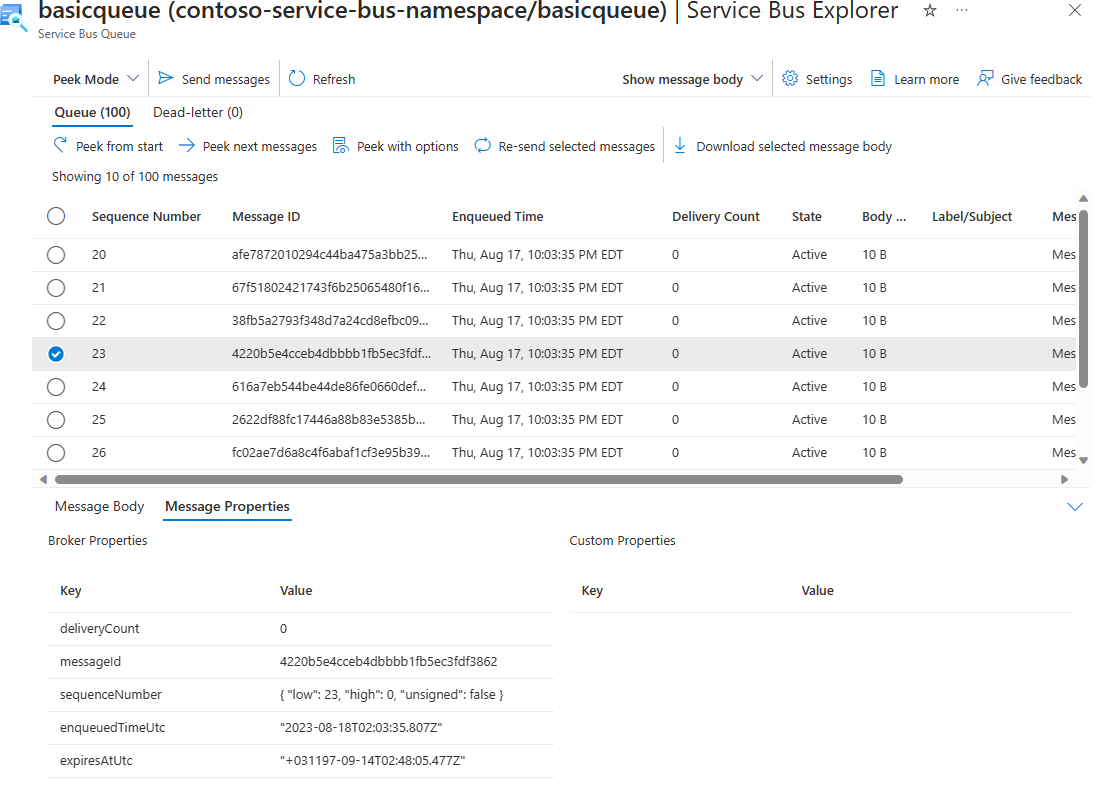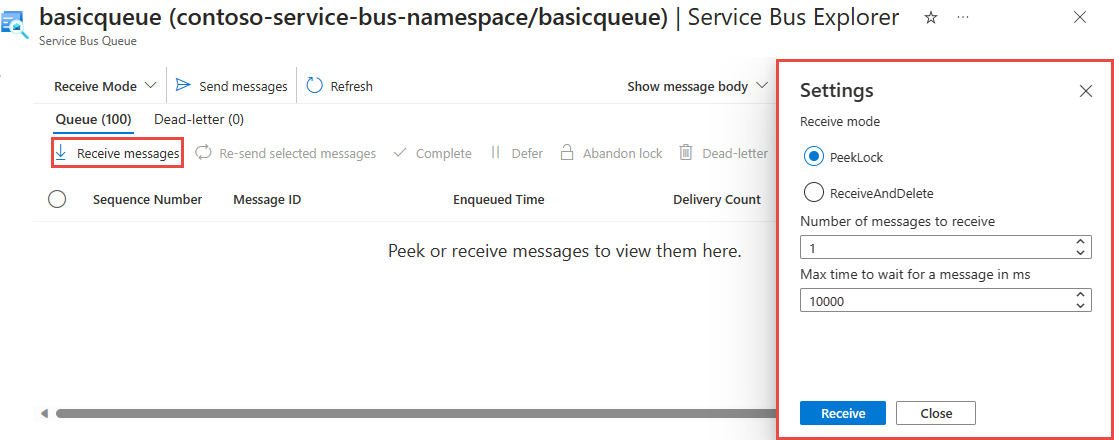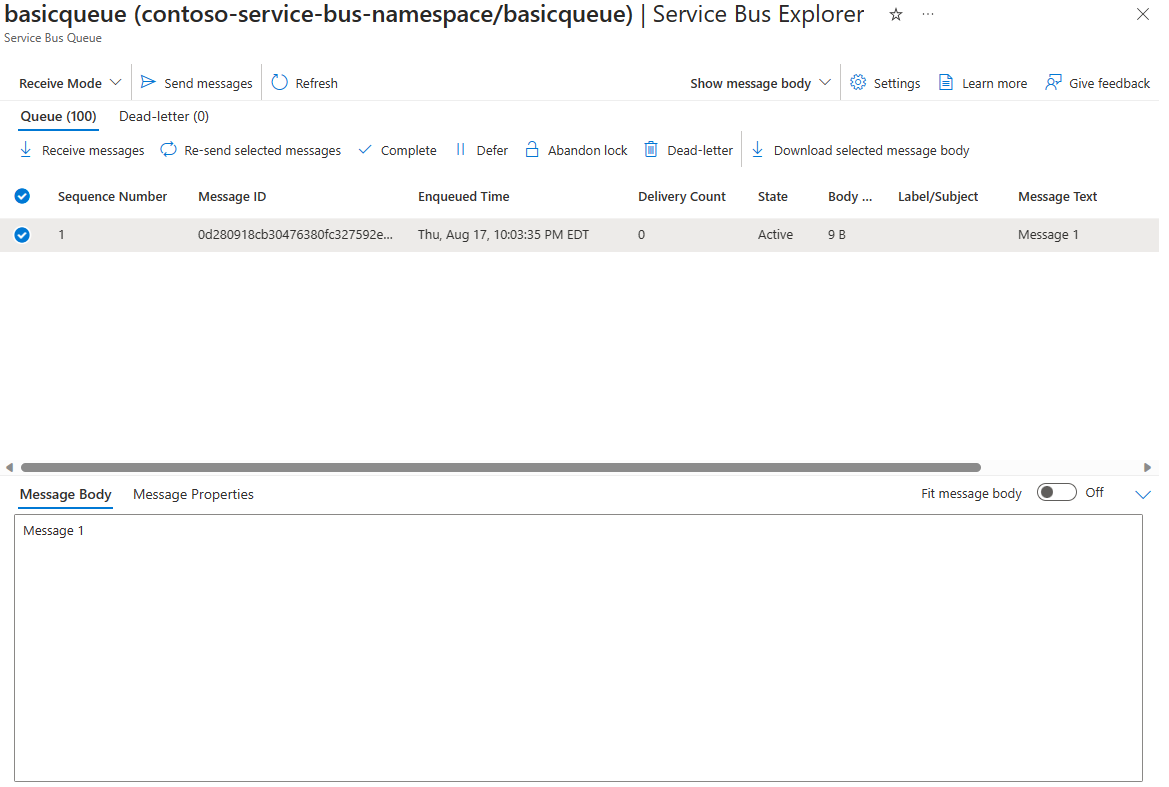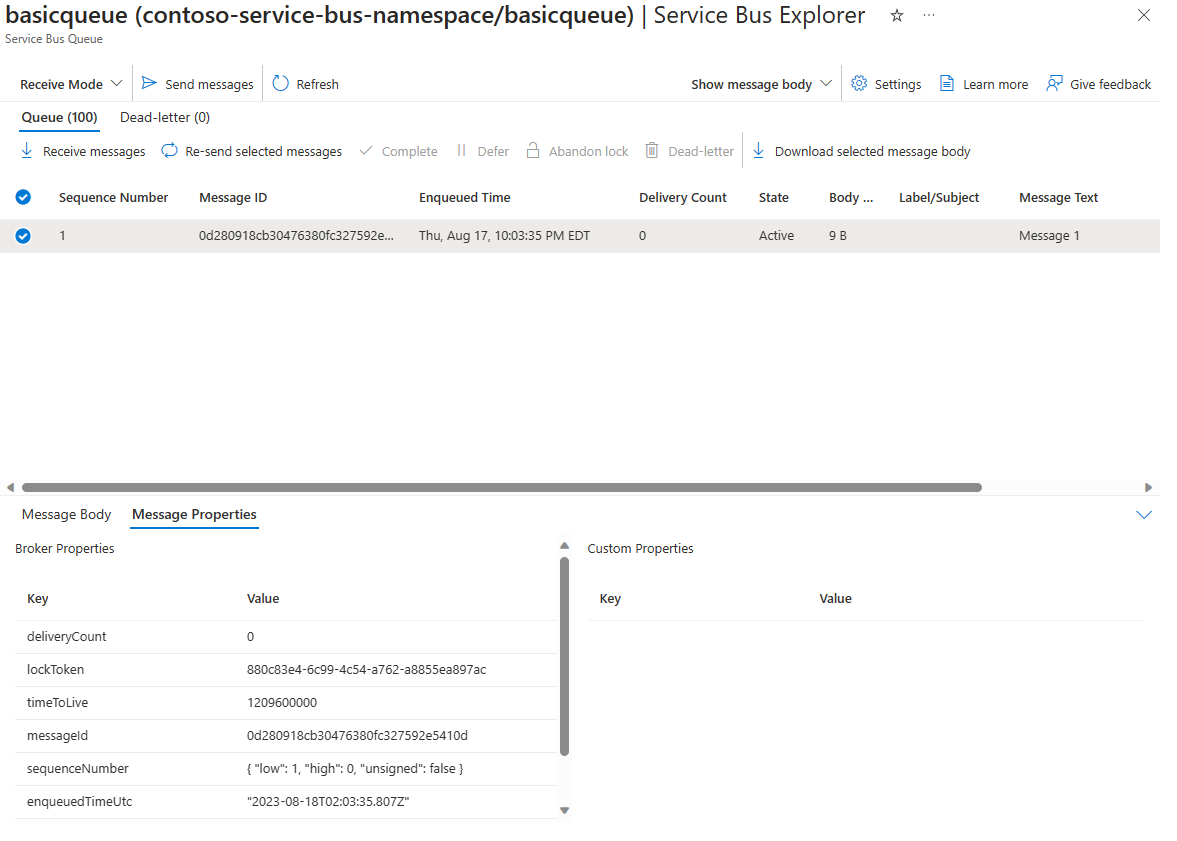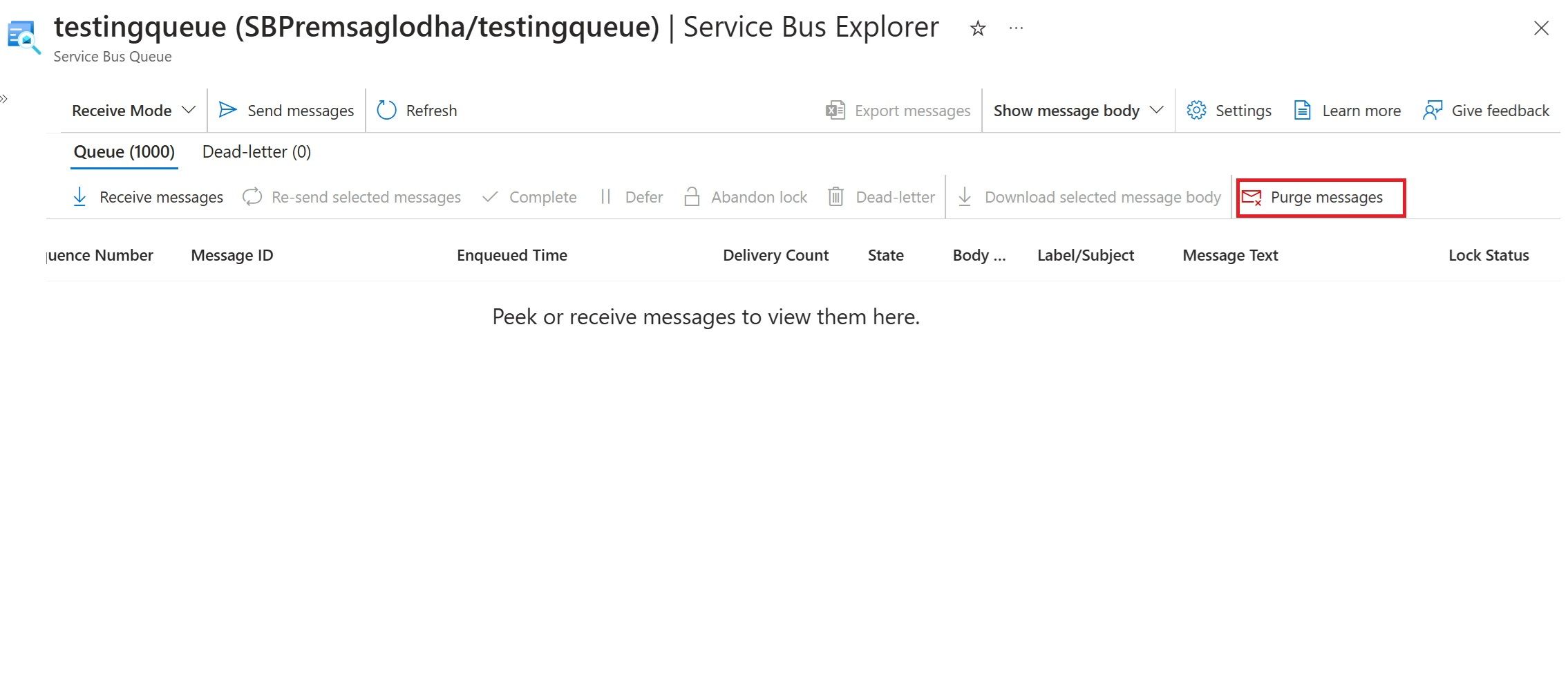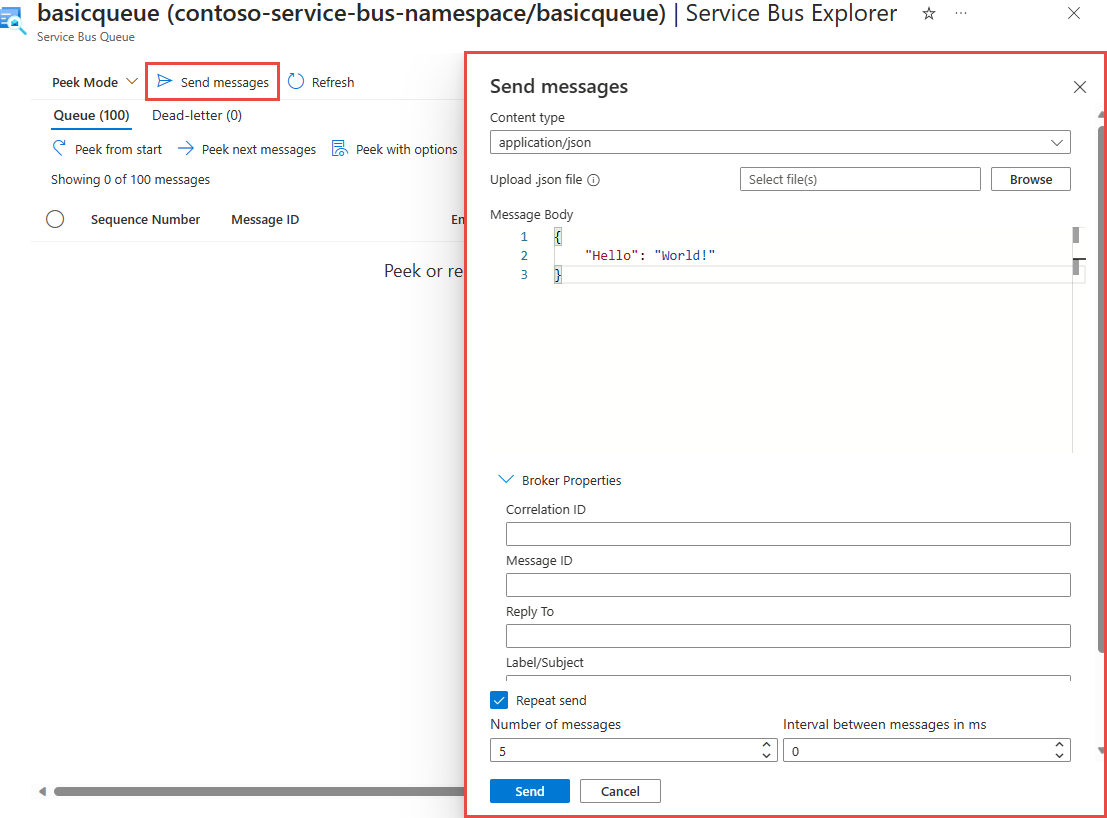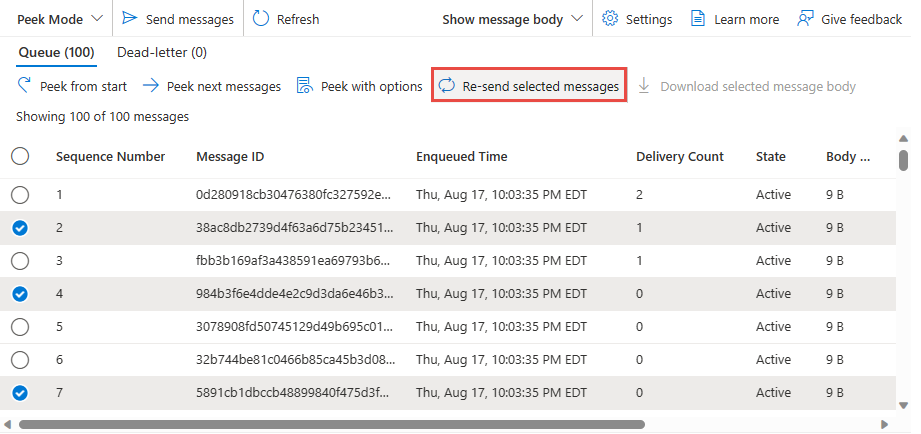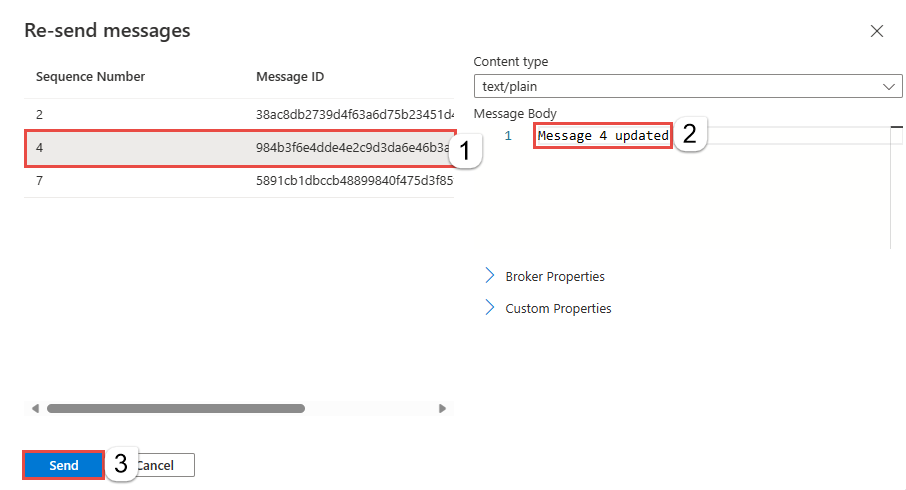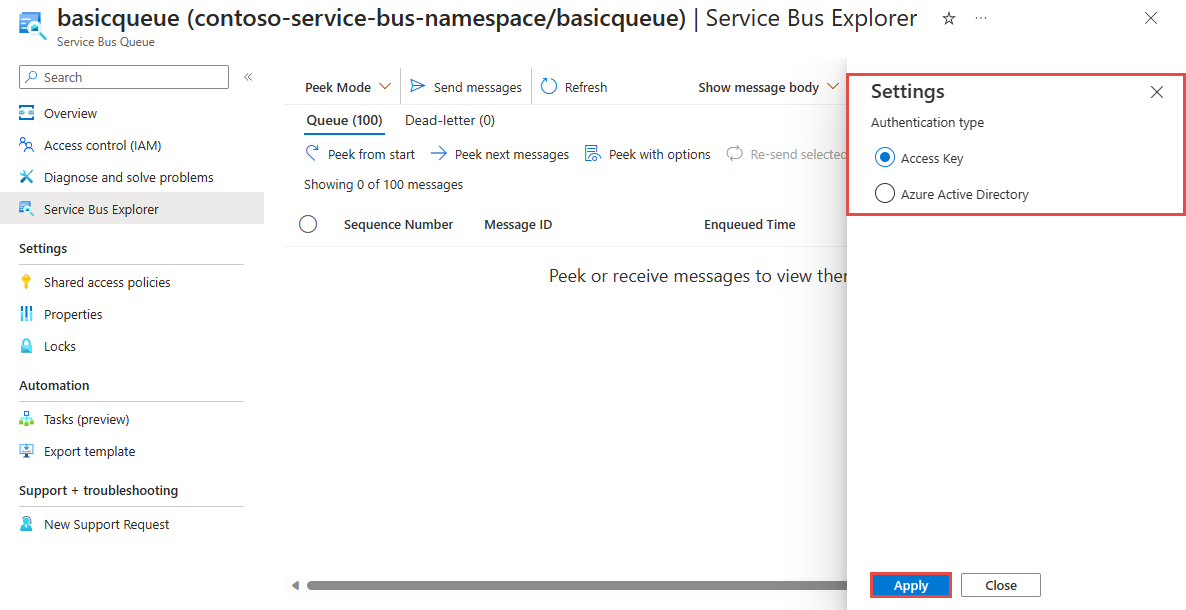Use Service Bus Explorer to run data operations on Service Bus
Azure Service Bus allows sender and receiver client applications to decouple their business logic with the use of familiar point-to-point (Queue) and publish-subscribe (Topic-Subscription) semantics.
Note
This article highlights the functionality of the Azure Service Bus Explorer that's part of the Azure portal.
The community owned open source Service Bus Explorer is a standalone application and is different from this one.
Operations run on an Azure Service Bus namespace are of two kinds.
- Management operations - Create, update, delete of Service Bus namespace, queues, topics, and subscriptions.
- Data operations - Send to and receive messages from queues, topics, and subscriptions.
Important
- Service Bus Explorer doesn't support management operations and sessions.
- We advice against using the Service Bus Explorer for larger messages, as it may result in time-outs, depending on the message size, network latency between client and Service Bus service etc. Instead, we recommend that you use your own client to work with larger messages, where you can specify your own time-out values.
- If your Service Bus namespace can only be accessed via a private endpoint, you must run your web browser on a host in the virtual network with the private endpoint, and also ensure that there are no network security gateways (NSGs) in the way.
Prerequisites
To use the Service Bus Explorer tool, you need to do the following tasks:
Create a queue to send and receive message from or a topic with a subscription to test out the functionality. To learn how to create queues, topics, and subscriptions, see the following articles:
Note
Ensure that you're a member of one of these roles on the namespace or the entities you want to execute send or receive (including peek and purge) operations on:
- Service Bus Data Owner; Allows both send and receive operations.
- Service Bus Data Sender; Allows send operations.
- Service Bus Data Receiver; Allows receive operations.
Use the Service Bus Explorer
To use the Service Bus Explorer, navigate to the Service Bus namespace on which you want to do data operations.
If you're looking to run operations against a queue, select Queues from the navigation menu. If you're looking to run operations against a topic (and its related subscriptions), select Topics.
After selecting Queues or Topics, select the specific queue or topic.
Select the Service Bus Explorer from the left navigation menu
Note
When peeking or receiving from a subscription, first select the specific Subscription from the dropdown selector.

Note
When you navigate to Service Bus explorer for an entity in a namespace that has the public access disabled, you see the following message even though you access it from a virtual machine that's in the same virtual network as the private endpoint. You can ignore it.
"The namespace has public network access disabled. Data operations such as Peek, Send, or Receive against this Service Bus entit don't work until you switch to all networks or allowlist your client IP in selected networks."
Peek a message
With the peek functionality, you can use the Service Bus Explorer to view the top 100 messages in a queue, subscription, or dead-letter queue.
To peek messages, select Peek Mode in the Service Bus Explorer dropdown.
Check the metrics to see if there are Active Messages or Dead-lettered Messages to peek and select either Queue / Subscription or DeadLetter subqueue.
Select the Peek from start button.
Once the peek operation completes, up to 100 messages show up on the grid as shown in the following image. To view the details of a particular message, select it from the grid. You can choose to view the body or the message properties.
Switch to the Message Properties tab in the bottom pane to see the metadata.
Note
Since peek isn't a destructive operation the message won't be removed from the entity.
Note
For performance reasons, when peeking messages from a queue or subscription which has its maximum message size set over 1 MB, the message body isn't retrieved by default. Instead, you can load the message body for a specific message by clicking on the Load message body button. If the message body is over 1 MB, it's not truncated before being displayed.
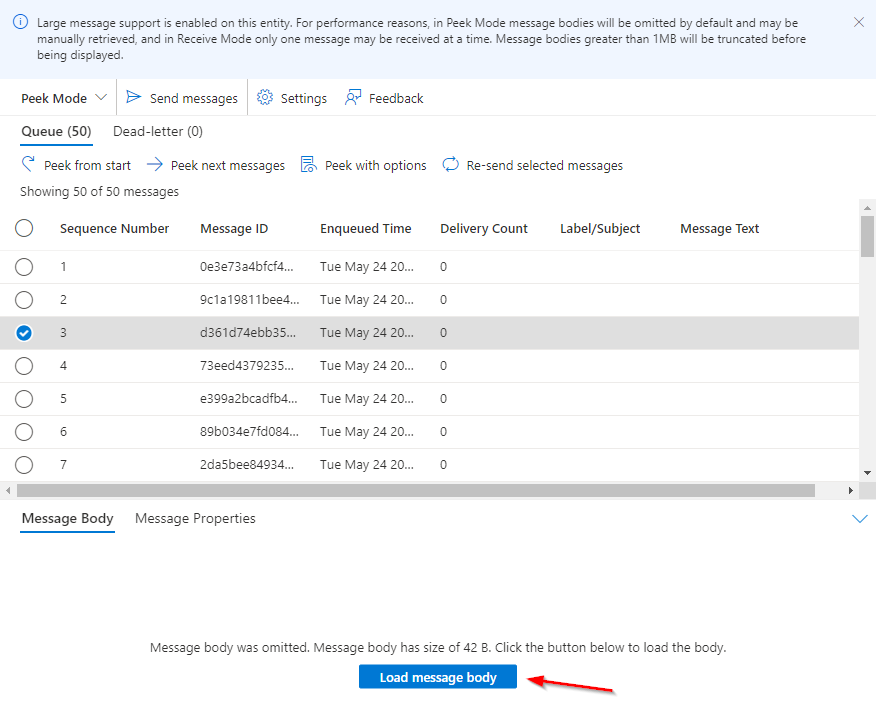
Peek a message with advanced options
The peek with options functionality allows you to use the Service Bus Explorer to view the top messages in a queue, subscription or the dead-letter queue, specifying the number of messages to peek, and the sequence number to start the peek operation.
To peek messages with advanced options, select Peek Mode in the Service Bus Explorer dropdown.
Check the metrics to see if there are Active Messages or Dead-lettered Messages to peek and select either Queue / Subscription or DeadLetter subqueue.
Select the Peek with options button. Provide the number of messages to peek, and the sequence number to start peeking from, and select the Peek button.
Once the peek operation completes, the messages show up on the grid as shown in the following image. To view the details of a particular message, select it from the grid. You can choose to view the body or the message properties.
Switch to the Message Properties tab in the bottom pane to see the metadata.
Note
Since peek isn't a destructive operation the message won't be removed from the queue.
Receive a message
The receive function on the Service Bus Explorer permits receiving messages from a queue or subscription.
To receive messages, select Receive Mode in the Service Bus Explorer dropdown.
Check the metrics to see if there are Active Messages or Dead-lettered Messages to receive, and select either Queue / Subscription or DeadLetter.
Select the Receive messages button, and specify the receive mode, the number of messages to receive, and the maximum time to wait for a message and select Receive.
Important
The ReceiveAndDelete mode is a destructive receive, that is, the message is removed from the queue when it's displayed on the Service Bus Explorer tool.
To browse messages without removing them from the queue, consider using the Peek functionality, or using the PeekLock receive mode.
Once the receive operation completes, the messages show up on the grid as shown in the following image. To view the details of a particular message, select it in the grid.
Note
For performance reasons, when receiving messages from a queue or subscription which has its maximum message size set over 1 MB, only one message is received at a time. If the message body is over 1 MB, it's truncated before being displayed.
After a message is received in PeekLock mode, there are various actions you can take on it.
Note
You can only take these actions as long as you have a lock on the message.
Complete a message
In the grid, select the received messages you want to complete.
Select the Complete button.
Important
Completing a message is a destructive receive, that is, the message is removed from the queue when Complete has been selected in the Service Bus Explorer tool.
Defer a message
In the grid, select one or more received messages you want to defer.
Select the Defer button.
Abandon lock
In the grid, select one or more received messages for which you want to abandon the lock.
Select the Abandon lock button.
After the lock is abandoned, the message is available for receive operations again.
Dead-letter
In the grid, select one or more received messages you want to dead-letter.
Select the Dead-letter button.
After a message is dead-lettered, it's available from the Dead-letter subqueue.
Purge messages
To Purge messages, select the Purge messages button of Service Bus explorer.
Once you enter 'purge' to confirm on the operation, messages would be purged from respective service bus entity.
Send a message to a queue or topic
To send a message to a queue or a topic, select the Send messages button of the Service Bus Explorer.
Select the Content Type to be either Text/Plain, Application/Xml or Application/Json.
For Message body, add the message content. Ensure that it matches the Content Type set earlier.
Set the Broker properties (optional). These properties include Correlation ID, Message ID, ReplyTo, Label/Subject, Time to Live (TTL) and Scheduled Enqueue Time (for Scheduled Messages).
Set the Custom Properties (optional). These properties can be any user properties set against a dictionary key.
Check Repeat send to send the same message multiple times. If no Message ID was set, it's automatically populated with sequential values.
Once the message is composed, select the Send button.
When the send operation is completed successfully, one of the following changes happens:
- If sending to a queue, Active Messages metrics counter is incremented.
- If sending to a topic, Active Messages metrics counter is incremented on the subscriptions where the message was routed to.
Resend a message
After peeking or receiving a message, you can resend it, which sends a copy of the message to the same entity, while allowing us to update it's content and properties. The original remains and isn't deleted even when resend is from the deadletter queue.
In the grid, select one or more messages you want to resend.
Select the Re-send selected messages button.
Optionally, select any message for which you want to update its details and make the desired changes.
Select the Send button to send the messages to the entity.
Note
- The resend operation sends a copy of the original message. It doesn't remove the original message that you resubmit.
- If you resend a message in a dead-letter queue of a subscription, a copy of the message is sent to the topic. Therefore, all subscriptions receive a copy of the message.
Switch authentication type
When working with Service Bus Explorer, it's possible to use either Access Key or Microsoft Entra ID authentication.
Next Steps
- Learn more about Service Bus Queues and Topics
- Learn more about creating Service Bus Queues via the Azure portal
- Learn more about creating Service Bus Topics and Subscriptions via the Azure portal
